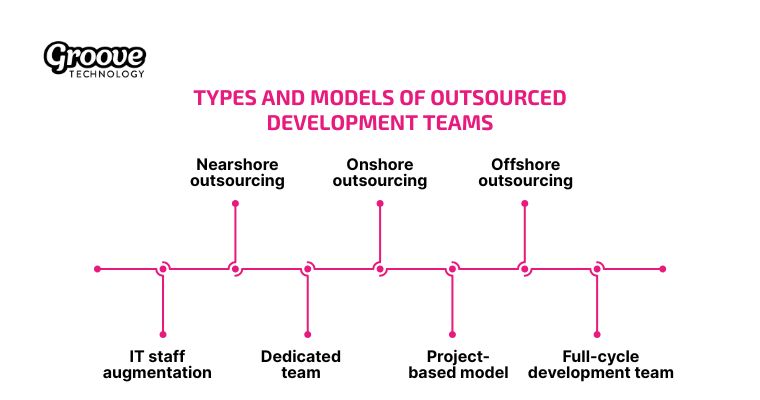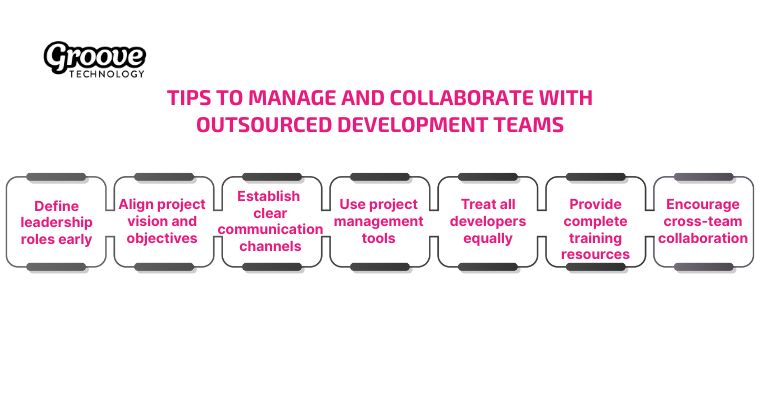How To Outsource Software Development Projects? A Complete Guide
Software development outsourcing refers to hiring an external company or third-party specialist to handle software-related tasks such as building, maintaining, or upgrading applications. This practice enables businesses to access experienced professionals, reduce costs, and expedite delivery timelines without managing a full in-house team.
Talent shortages and rising operational costs continue to drive the expansion of outsourcing in software development. Approximately 87% of global companies face or anticipate IT skill shortages, while 70% cite cost reduction as the primary reason for hiring external teams. Location differences also play a significant role, as Eastern European developers charge between $25 and $50 per hour, compared with up to $150 per hour for onshore teams. While outsourcing offers substantial savings, time zone gaps and cultural mismatches may affect collaboration if not managed carefully.
This article will explain:
- What does software development outsourcing mean
- Why global companies prefer outsourcing developer teams
- The types and models of outsourced development
- Seven steps for successful outsourcing
- Who should outsource and what risks to avoid
- How to manage collaboration effectively
Anyone seeking clarity on how to work with an offshore software development outsourcing company will gain practical knowledge from this guide that connects every stage of the outsourcing process.

1. What is software development outsourcing?
Software development outsourcing is the strategic move of hiring an external team to manage your product's technical execution, whether that covers the entire lifecycle or just specific coding and testing tasks. This action can be implemented as three types: onshore, nearshore, or offshore, depending on cost, talent availability, and communication needs. It allows businesses to leverage global technical expertise without expanding their in-house teams.
The demand is real and it is growing fast. According to Mordor Intelligence, the country’s IT services market is projected to reach approximately USD 77.8 billion by 2030, supported by a remarkable CAGR of 19.24%. That sharp upward trend signals a clear shift: companies are prioritizing agility and expert access over building massive internal fortresses.

2. 7 Steps to help you successfully outsource software development
If you're wondering how to outsource software development effectively, following these 7 essential steps will help ensure your outsourcing journey is successful. Understanding each stage of the outsourcing software development process will allow you to manage expectations, improve collaboration, and deliver results efficiently.
Step 1: Define project goals, scope, and requirements
Project definition establishes the foundation for successful software outsourcing partnerships. Companies must create detailed scope documents that outline objectives, deliverables, functionality requirements, and performance expectations. Technology specifications and preferred frameworks guide vendor selection and project execution.
Skills assessment and experience requirements shape team composition and project outcomes. Organizations should develop comprehensive project charters that identify timeline constraints, budget parameters, and regulatory compliance needs. Stakeholder approval prevents scope creep and maintains project alignment throughout development cycles.
Research validates the importance of clear requirements in outsourcing success. A 2023 Deloitte study reveals that 81% of executives cite clear requirements as critical factors for achieving outsourcing success, while 52% of companies outsource to address AI-related skill gaps, according to their 2022 survey.
Step 2: Estimate budget and evaluate cost considerations
Budget estimation goes far beyond picking a number—it requires precise calculation of professional rates, team size, vendor margins, and project duration to build a financially sound foundation. A comprehensive framework must account for hourly rates, timeline projections, and any commission or overhead charged by outsourcing partners. This approach not only helps prevent unexpected cost overruns, but also sets clear cost expectations for internal stakeholders, streamlining approval and planning processes.
That said, conducting a market rate analysis is critical. Vendors offering rates far below industry benchmarks may signal potential quality risks, vendor lock-in strategies, or hidden long-term costs. What seems affordable today could turn into a costly dependency down the road.
Smart budget allocation strikes a balance between cost competitiveness and quality assurance. Don’t just seek the lowest rate, seek the best value. Also, be sure to define the payment structure upfront, whether hourly, milestone-based, or fixed-price, to ensure transparency and better financial control.

Step 3: Select the outsourcing model and location
Choosing the right software development outsourcing models and location is a critical step that shapes the structure, efficiency, and long-term success of your software development project. To make an informed decision, businesses should carefully consider both how they want to collaborate and where their partners should be located.
There are three primary outsourcing models, each offering a different balance of control, responsibility, and flexibility:
- Staff augmentation: This model allows companies to extend their in-house development capacity by bringing in external developers who work as part of the internal team. It's ideal when you need specialized expertise or temporary scaling, while still maintaining full control over project direction and workflows.
- Dedicated or managed team: In this setup, an external team works exclusively on your projects under a collaborative partnership. You benefit from a focused, cross-functional team that shares responsibility for delivery, while you stay involved in strategy and priority setting. It's a strong fit for long-term initiatives requiring tight integration and shared ownership.
- Project-based outsourcing: Here, the outsourcing partner takes full responsibility for project execution, from planning to delivery. The client’s role becomes more strategic, focusing on high-level goals, vision, and approvals, while the partner manages the day-to-day execution. This is suitable for companies with limited technical resources or for self-contained projects with clear scopes.
Once the model is defined, the next step is selecting a geographic location for your outsourcing partner. This decision affects everything from cost and time zone alignment to legal protections and cultural compatibility.
- Onshore outsourcing offers seamless communication, shared legal frameworks, and strong IP protection. However, it tends to be more expensive.
- Nearshore outsourcing (e.g., to countries in Latin America or Canada for U.S. companies) balances cost savings with convenient time zone overlap and similar business culture.
- Offshore outsourcing (e.g., Eastern Europe, Vietnam, India) provides the most cost-effective options, with many countries offering highly skilled talent at significantly lower rates.
According to a Deloitte report, 59% of businesses outsource to reduce costs, while 57% do so to focus on core business functions. That’s why finding the right model and location is not just about saving money, it’s about aligning your outsourcing strategy with your company’s overall growth goals.
>>> See more: Types of Software Development Outsourcing Models: Find the Best Model for Your Project
Step 4: Research and select a reliable partner
When it comes to outsourcing software development, the first and arguably most important step is choosing the right country to outsource to. Each region offers distinct advantages and limitations that can directly impact collaboration efficiency and product quality.
Today, Eastern Europe and Latin America are emerging as strong outsourcing hubs due to their competitive rates and skilled engineering talent. Increasingly, Vietnam is also emerging as a competitive outsourcing destination. The country offers a highly skilled, youthful workforce with strong English capabilities, and software development costs that are often 50–70% lower than in many Western countries. For startups and SMEs looking to balance quality and cost, choosing the best software outsourcing company in Vietnam is an attractive option worth considering.
It’s also wise to collaborate with global hiring platforms or trusted recruiting partners. These organizations often have direct connections with top universities and reputable software vendors in specific regions. They can quickly refer you to vetted, high-quality partners, saving you both time and risk.
Once you’ve identified promising regions and potential vendors, evaluate them across several key factors:
- Portfolio and case studies – What have they built? For whom? How successful were the outcomes?
- Company size and business longevity – Older, more established teams typically have more stable operations and defined processes.
- Industry-specific experience – Vendors with relevant domain knowledge can ramp up quickly and deliver better results.
- Time zone compatibility – Crucial for smooth, real-time collaboration.
- Transparent pricing structure – Watch for hidden fees or vague billing models.
To validate this information, use software review websites like Clutch or GoodFirms, consult industry peers, or request direct references from past clients. With the right groundwork, you’ll be well-positioned to move forward confidently with a reliable and cost-effective partner.
>>> See more: How To Choose a Software Outsourcing Company? A Best Guide

Step 5: Establish legal, communication, and project management frameworks
Even after selecting the right partner and finalizing your budget, your outsourcing project won’t succeed without a robust framework for legal protection, effective communication, and transparent project management.
On the legal side, make sure to sign contracts that clearly outline intellectual property ownership, NDA clauses, payment schedules, delivery timelines, and protocols for dispute resolution. If you're outsourcing internationally, ensure your partner is aligned with global legal standards and compliant with data regulations like GDPR or HIPAA, if applicable.
For communication, implement a regular, multi-channel workflow, using tools like Slack, Zoom, or email, and establish a shared language for all deliverables. Assigning a dedicated Product Owner or primary point of contact can minimize miscommunications and improve turnaround times. When it comes to project management, use tools such as Jira, Trello, ClickUp, or Asana to track milestones, manage tasks, and ensure complete transparency throughout the development lifecycle.
Step 6: Monitor progress and provide feedback
Outsourcing doesn’t mean handing off the work and walking away. On the contrary, staying actively involved is crucial to ensure both progress and quality. Set a clear work schedule, hold regular check-in meetings, and use project management tools like Trello, Jira, or Asana to keep everything on track.
Equally important is giving timely and constructive feedback. Help your partner understand expectations clearly by pointing out specific issues and offering actionable suggestions. Avoid vague comments—instead, provide detailed input that helps improve the product.
Also, don’t forget that feedback is a two-way street. Be open to insights from your development partner—they may identify risks you haven’t considered or suggest more efficient solutions. When both sides align around a shared goal, productivity and outcomes improve significantly.
Step 7: Implement quality control and knowledge transfer
An outsourced project shouldn’t be considered complete the moment the code is delivered. Long-term success depends on continuous quality control and smooth knowledge transfer to your internal team.
Start by implementing a robust QA process, including unit tests, integration tests, and user acceptance testing (UAT). Ask your partner to provide automated testing reports regularly or participate in live test sessions with your team.
Next, ensure that all technical documentation, architecture diagrams, credentials, source code, and user guides are fully handed over. This is crucial for future scalability, seamless onboarding of new team members, or transitioning to another vendor if needed.
Lastly, schedule retrospective sessions after key milestones. These reviews help identify what worked well and what needs improvement—fostering both higher performance and stronger long-term collaboration.

3. Why do more global companies hire an outsourcing software development team?
More global companies hire outsourcing software development teams because it helps them cut costs, accelerate delivery, and stay focused on their core business operations. Around 64% of companies worldwide outsource at least part of their software development. Outsourcing can help organizations reduce development costs by up to 40% and shorten time-to-market by 50%, while allowing them to focus on their core business activities.
So, what is driving this growing trend? Here’s how to outsource software development effectively, with five key reasons why more companies are turning to outsourced software development teams.
- Cost savings: Your business can significantly reduce internal expenses related to employee salaries, recruitment, and IT infrastructure. By partnering with outsourcing providers who already have established teams and lower labor costs, your business avoids unnecessary investments. As a result, you shorten development cycles, bring products to market faster, and maintain tighter budget control.
- Increased efficiency: When you collaborate with highly experienced outsourcing teams, your business benefits from proven methods, frameworks, and technologies. Their expertise reduces trial-and-error delays, accelerates project timelines, improves code quality, and allows your in-house team to focus on strategic initiatives without sacrificing productivity.
- Scalability: Your business can easily scale resources up or down based on project requirements. During peak periods, you can quickly onboard additional developers; when workloads decrease, you can scale down without heavy fixed costs. This flexibility helps your business stay agile, minimize waste, and maintain consistent timelines despite market changes.
- Focus on core competencies: By shifting technical workloads externally, your internal team gains more time to focus on strategic areas such as product design, branding, and customer experience. This separation of responsibilities helps your business maintain innovation, strengthen key departments, and achieve a more efficient workflow overall.
- Access to global talent pool: Outsourcing gives your business direct access to global talent with diverse industry backgrounds and advanced technical skills. Many of these professionals have worked at major tech companies and follow high-level coding standards. This diversity not only enriches your project outcomes but also provides premium expertise at more cost-effective rates.
4. Types and models of outsourced development teams
Outsourcing can be organized in three types and four models, depending on the level of control, flexibility, and cost efficiency a business requires
Types of outsourced development teams:
- Onshore outsourcing: External software teams operate within the same country but in different cities or regions. This model supports real-time communication, cultural familiarity, and easy travel for in-person meetings. However, high local labor rates can increase project costs, particularly in regions such as the USA or Australia. It suits businesses that value close coordination and clear communication more than cost reduction.
- Nearshore outsourcing: Development work is handled by companies in neighboring countries, such as a French firm outsourcing to Portugal. Proximity helps reduce travel time and manage time zone overlap, while keeping expenses lower than those of onshore options. However, cost savings are smaller than those of offshore models, and access to talent may vary by region. It fits companies seeking a balance between affordability and effective collaboration.
- Offshore outsourcing: Teams from distant countries provide development services at much lower rates, such as U.S. firms working with partners in Vietnam or Eastern Europe. This model provides access to diverse global talent, offers large scalability, and offers the most competitive pricing. However, time zone differences and communication challenges require structured coordination. It benefits organizations focused on cost efficiency and global reach.
Outsourced development teams model:
- IT staff augmentation: Businesses temporarily hire external experts to strengthen their in-house teams and fill specific technical gaps. This setup provides companies with control over project management and rapid access to specialized skills without the need for long-term hiring. The challenge lies in training and supervision, as temporary staff still require onboarding. It works best for firms that require rapid scaling or specialized niche expertise.
- Dedicated team: A dedicated outsourcing team handles defined project scopes, including developers, designers, and QA engineers who work independently yet align with client goals. This setup offers strong project ownership and reduces internal workload. However, costs can be higher than those of staff augmentation, and integrating teams may require significant effort. It fits organizations running large or ongoing projects.
- Project-based model: The outsourcing partner manages the entire project lifecycle, adhering to predefined goals, budgets, and deadlines. Clients benefit from predictable costs and minimal involvement once the scope is fixed. The drawback is reduced flexibility to adjust during execution. This model suits those with well-structured requirements and limited in-house development resources.
- Full-cycle development team: This model encompasses every phase from concept and design to deployment and maintenance, which is handled by a single partner. It promotes long-term collaboration, continuous product updates, and consistent quality. Yet, ongoing costs are higher, and dependency on the vendor can increase. It is suitable for companies aiming for continuous growth and product improvement.

5. Who is suitable for outsourcing software development?
Outsourcing software development can be particularly beneficial for:
- Startups with limited resources
- Small to medium-sized businesses looking to scale quickly
- Large enterprises seeking specialized skills
- Non-tech companies needing custom software solutions
- Companies with fluctuating development needs
- Businesses looking to reduce operational costs
- Organizations aiming to accelerate digital transformation
Understanding how to outsource software development properly allows them to maximize these benefits and build sustainable partnerships.

6. Tips to outsource and manage development teams effectively
Managing outsourced software development requires establishing clear processes, maintaining consistent communication, and building a foundation of mutual trust. The seven tips below help you streamline coordination, strengthen accountability, and create a more cohesive partnership between your internal team and your external developers.
- Define leadership roles early: You should clearly identify the key decision-maker from day one. When you assign a dedicated point of contact, you eliminate confusion for your outsourced team and prevent tasks from slipping through the cracks. As a result, you keep the workflow moving smoothly without unnecessary back-and-forth.
- Align on project vision and goals: You shouldn’t simply hand over a task list; instead, you should explain the purpose and intention behind the product. When you help your outsourced team understand the soul of the project—not just the code—you ensure that everyone works toward the exact same objective.
- Establish clear communication channels: From the start, you need to set a consistent communication rhythm. Whether you choose daily stand-ups or weekly sprint reviews, you should create a reliable space for real-time discussion. This helps you shorten feedback loops and catch misunderstandings before they become costly problems.
- Use project management tools: You should bring everyone onto the same platform. By using tools like Jira, Asana, or Trello, you create a single source of truth for tracking progress. This reduces the number of status meetings you need and allows developers to focus on writing high-quality code.
- Treat all developers equally: You must avoid creating an “us vs. them” dynamic. When you treat outsourced engineers as full members of the team, you encourage stronger ownership and more proactive engagement. This helps you foster a positive and productive working environment.
- Provide complete training resources: You shouldn’t force your outsourced developers to reverse-engineer your legacy systems. Instead, you should give them full access to documentation, onboarding materials, and technical resources from the beginning. This enables them to ramp up quickly and contribute effectively sooner.
- Encourage cross-team collaboration: Finally, you should encourage your internal team and outsourced developers to brainstorm and solve problems together. By promoting this collaboration, you not only create stronger technical solutions but also build natural trust, turning a transactional arrangement into a true partnership.

7. Conclusion
Outsourcing software development can be a game-changer for businesses seeking to innovate and scale efficiently. By understanding the advantages and outsourcing software development process, addressing potential challenges, and learning how to outsource software development effectively, you can harness the full potential of outsourcing. Remember to choose your outsourcing partner carefully, considering factors like expertise, cultural fit, and long-term compatibility.
Understanding how to outsource software development with the right strategy and partner can drive your business towards greater success and competitiveness in the digital age. Connect Groove Technology for more information!
Related Articles:
- What Software Staff Augmentation Means for Agile Product Teams
- Dedicated Software Development Teams: Key to Long-Term Project Success
- Hiring Outsourcing Software Developer Team: A Startup-Friendly Solution





